Please use this identifier to cite or link to this item:
https://rima.ufrrj.br/jspui/handle/20.500.14407/21097| Tipo do documento: | Dissertação |
| Title: | Utilização das tecnologias digitais de informação e comunicação na Educação Física escolar |
| Other Titles: | Use of digital information and communication technologies in school Physical Education |
| Authors: | Guerra, Anderson da Silva Santos |
| Orientador(a): | Oliveira, Aldair José de |
| Primeiro membro da banca: | Oliveira, Aldair José de |
| Segundo membro da banca: | Pires, Valéria Nascimento Lebeis |
| Terceiro membro da banca: | Fonseca Junior, Sidnei Jorge |
| Keywords: | Tecnologias Digitais de Informação e Comunicação;Educação;Educação Física escolar;Digital Information and Communication Technologies;Education;School Physical Education |
| Área(s) do CNPq: | Educação Física Educação Física |
| Idioma: | por |
| Issue Date: | 30-Aug-2024 |
| Publisher: | Universidade Federal Rural do Rio de Janeiro |
| Sigla da instituição: | UFRRJ |
| Departamento: | Instituto de Educação |
| Programa: | Programa de Pós-Graduação em Educação Física |
| Citation: | GUERRA, Anderson da Silva Santos. Utilização das tecnologias digitais de informação e comunicação na Educação Física escolar. 2024. 124 f. Dissertação (Mestrado Profissional em Educação Física em Rede Nacional - ProEF) - Instituto de Educação, Universidade Federal Rural do Rio de Janeiro, Seropédica, RJ, 2024. |
| Abstract: | As Tecnologias Digitais de Informação e Comunicação (TDIC), reforçam o caráter digital de dispositivos tecnológicos como: tablets, computadores, celulares e laptops, conectados à internet, possibilitando múltiplas conexões em redes, comunicação multidirecional, produção de conhecimento, criação e publicação de informações. Todas essas possibilidades podem ser usadas a favor da Educação e, mais especificamente, da Educação Física, contribuindo com o desenvolvimento dos alunos e alunas, tanto nos aspectos ligados às especificidades da disciplina, quanto aos novos desafios proporcionados pela evolução tecnológica. No entanto, para que isso aconteça, é necessário que tenhamos professores(as) motivados(as), fundamentados(as) e com condições propícias para incorporar as TDIC em suas aulas. Diante disso, esse estudo teve como objetivo, investigar a motivação docente e aspectos ligados à utilização das Tecnologias Digitais de Informação e Comunicação (TDIC), junto a professores(as) de Educação Física dos anos finais do Ensino Fundamental. O estudo foi realizado no contexto da cidade de São Pedro da Aldeia/RJ, com 21 professores(as) das redes estadual, municipal e privada. Caracteriza-se como um estudo qualiquantitativo, dividido em duas fases. Na primeira, os(as) participantes responderam um questionário sociodemográfico e emitiram seu grau de concordância através de uma escala Likert de 5 pontos, anexada aos 24 itens da Escala de Motivação Docente (EMD), instrumento validado para o Brasil em um estudo de Davoglio; Santos (2017). Na segunda fase do estudo os(as) professores(as) foram convidados(as) a participar de entrevista semiestruturada (com roteiro elaborado especificamente para o estudo) e on-line, onde foram abordados temas ligados à utilização das TDIC nas suas aulas e no seu cotidiano. Os resultados obtidos na primeira fase, através da EMD, revelam que os 21 participantes somaram 2.099 pontos, de um total de 2.520, ou seja, 83,3%. Os resultados da segunda fase foram divididos em três categorias: (1) Utilização e fatores justificadores de (des) motivação com relação às TDIC; (2) TDIC e as condições proporcionadas pela escola; (3) Metodologia e material pedagógico envolvendo as TDIC. Os professores mostraram-se a favor da utilização das TDIC tanto nas aulas de Educação Física, quanto no cotidiano, porém, destacaram a importância do uso planejado, crítico e moderado, tanto na escola quanto no dia a dia. A infraestrutura adequada e o dinamismo das TDIC são fatores motivadores para o seu uso nas aulas. Enquanto a falta de infraestrutura e a possível perda de foco, por parte do(a) aluno(a), durante a utilização das TDIC, são fatores desmotivadores. As condições proporcionadas pelas escolas, para utilização das TDIC junto aos(às) alunos(as), são consideradas insuficientes na sua maioria, existindo algumas que se destacam por ofertá-las com qualidade. Percebe-se o comprometimento dos professores, ao tentar inserir de maneira crítica, essas tecnologias em suas aulas, através de propostas pedagógicas planejadas e constante avaliação do processo. O material digital também é considerado importante, porém, não é visto como a única forma de apoio pedagógico. |
| Abstract: | Digital Information and Communication Technologies (TDIC), reinforce the digital character of technological devices such as tablets, computers, cell phones and laptops, for example, connected to the Internet, enabling multiple connections to networks, multidirectional communication, knowledge production, creation and publication of information. All of these possibilities can be used in favor of education and, more specifically, physical education, contributing to the development of students and students, both in the specificities of the discipline and the new challenges provided by technological evolution. However, for this to happen, we must have teachers motivated, based and with conducive conditions to incorporate TDIC into their classes. Given this, this study aimed to investigate the teaching motivation and aspects related to the use of Digital Information and Communication Technologies (TDIC), with teachers of physical education of the final years of elementary school. The study was conducted in the context of the city of São Pedro da Aldeia/RJ, with 21 teachers of state, municipal and private networks. It is characterized as a qualitative study, divided into two phases. In the first, the participants answered a sociodemographic questionnaire and issued their degree of agreement through a 5 -point Likert scale, attached to the 24 items of the Teacher Motivation Scale (EMD), a validated instrument for Brazil in a study by Davoglio ; Santos (2017). In the second phase of the study the teachers were invited to participate in semi-structured interviews (with script specifically for the study) and online, where topics related to the use of TDICs were addressed in their classes and in your daily life. The results obtained in the first phase, through EMD, reveal that the 21 participants totaled 2,099 points, out of a total of 2,520, ie 83.3%. The results of the second phase were divided into three categories: (1) use and justifying factors of (dis) motivation regarding TDIC; (2) TDIC and the conditions provided by the school; (3) Methodology and pedagogical material involving the TDIC. The teachers were in favor of using TDIC in both physical education classes and daily life, however, highlighted the importance of planned, critical and moderate use, both at school and everyday life. TDIC's proper infrastructure and dynamism are motivating factors for their use in class. While the lack of infrastructure and the possible loss of focus by the student, during the use of TDIC, are demotivating factors. The conditions provided by schools, for the use of TDICs with the students, are considered insufficient mostly, with some that stand out for providing them with quality. The commitment of teachers is perceived, when trying to critically insert, these technologies in their classes, through planned pedagogical proposals and constant evaluation of the process. Digital material is also considered important, but it is not seen as the only form of pedagogical support. |
| URI: | https://rima.ufrrj.br/jspui/handle/20.500.14407/21097 |
| Appears in Collections: | Mestrado Profissional em Educação Física em Rede Nacional |
Se for cadastrado no RIMA, poderá receber informações por email.
Se ainda não tem uma conta, cadastre-se aqui!
Files in This Item:
| File | Description | Size | Format | |
|---|---|---|---|---|
| 2024 - Anderson da Silva Santos Guerra.Pdf | 2.18 MB | Adobe PDF |  View/Open |
Items in DSpace are protected by copyright, with all rights reserved, unless otherwise indicated.

